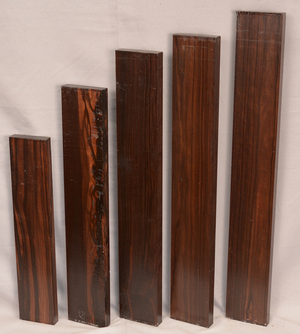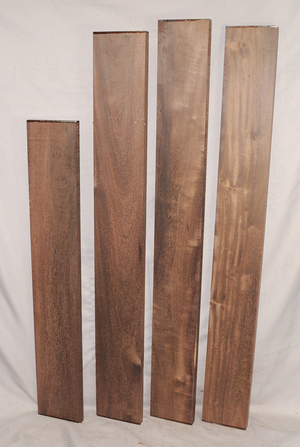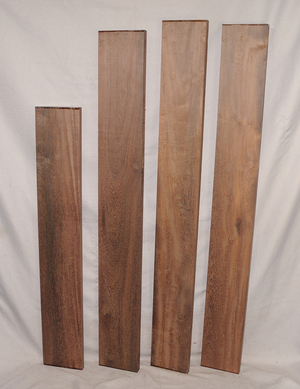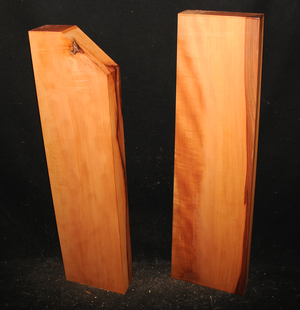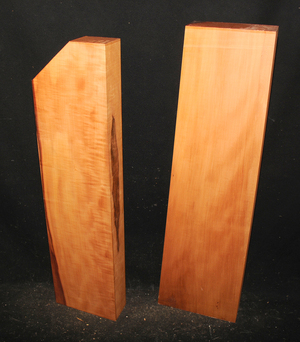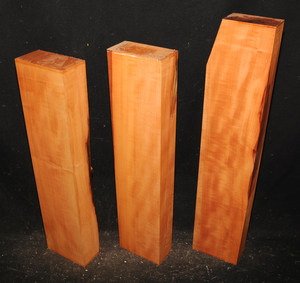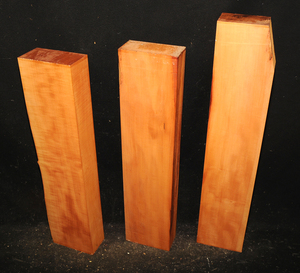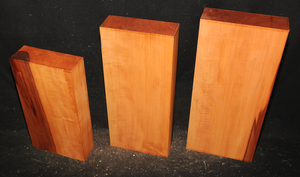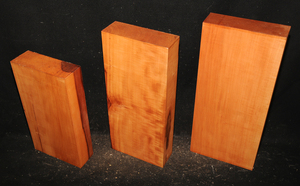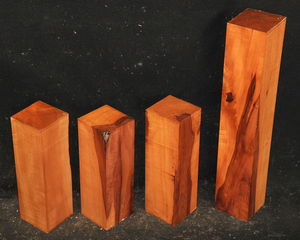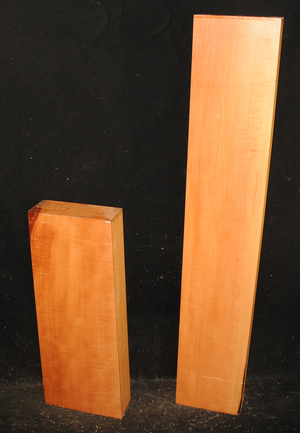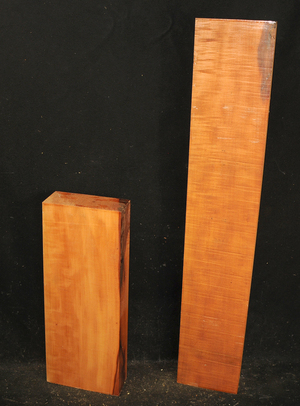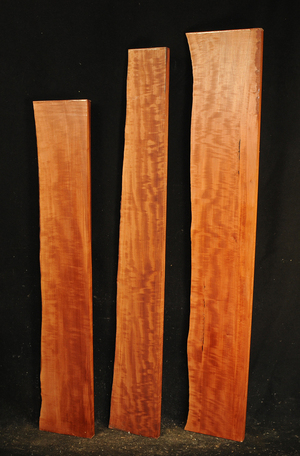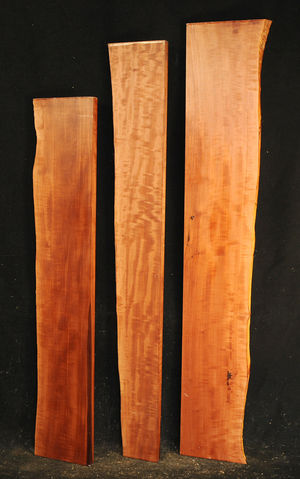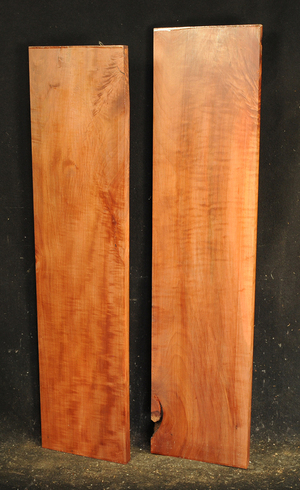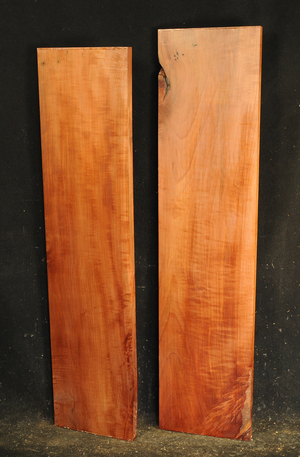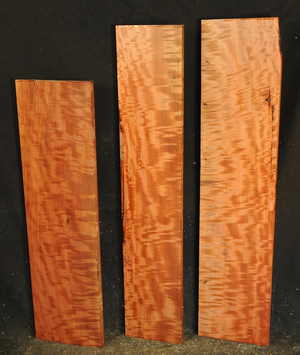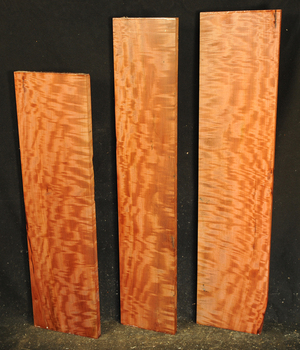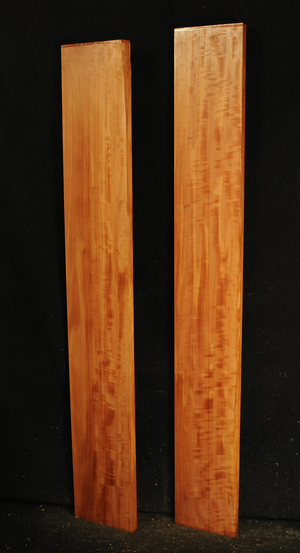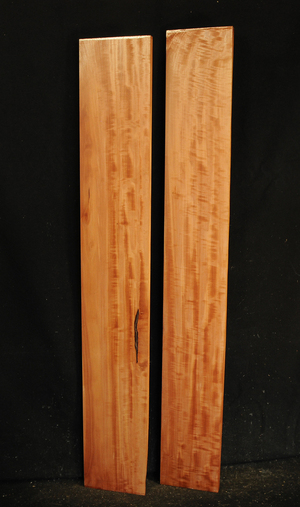Sabah Ebony
Diospyros sp
This Indonesian Ebony is also known as Kayu Malam. It usually has nice striping on the radial face and is easy to work and sand and takes a very nice finish. Used for cabinetry, furniture, turned objects, jewelry cases, knife handles, and other precious items. Air-dried.
Item Number: W40181
Sabah Ebony
Diospyros sp
This Indonesian Ebony is also known as Kayu Malam. It usually has nice striping on the radial face and is easy to work and sand and takes a very nice finish. Used for cabinetry, furniture, turned objects, jewelry cases, knife handles, and other precious items. Air-dried.
Item Number: W40179
Sabah Ebony Turning Squares
Diospyros sp
This Indonesian Ebony is also known as Kayu Malam. It usually has nice striping on the radial face and is easy to work and sand and takes a very nice finish. Used for cabinetry, furniture, turned objects, jewelry cases, knife handles, and other precious items. Air-dried.
Item Number: W40177
West African Ebony
Diospyros sp.
Originating in S.E. Asia, especially Indonesia, this Ebony is sometimes called Malaysian Blackwood. The heartwood is dark, sometimes with black stripes or streaking and oftentimes with a greenish cast in sharp contrast to the white to straw colored sapwood. We import this in large cants up to 8 x 14" with lengths to 10 feet. The wood is hard and heavy and is capable of a fine, high polish. Excellent for turnery and precious woodworks such as musical instruments, boxes, jewelry, etc.
Item Number: W39576
New Guinea Striped Ebony Turning Squares/Pool Cue Blanks
Diospyros insularis
This wood originated from a small, sparsely inhabited island off the east coast of New Guinea. Some of these trees grow to enormous dimensions. One of the first logs we received from here was 3 1/2 feet in diameter, 18 feet long, and weighed 7 tons. It is fine-grained and takes a glassy smooth finish. Most of these pieces have a "marble-cake" look to the end grain that is outstanding.
Item Number: W42722
New Guinea Striped Ebony Turning Squares/Pool Cue Blanks
Diospyros insularis
This wood originated from a small, sparsely inhabited island off the east coast of New Guinea. Some of these trees grow to enormous dimensions. One of the first logs we received from here was 3 1/2 feet in diameter, 18 feet long, and weighed 7 tons. It is fine-grained and takes a glassy smooth finish. Most of these pieces have a "marble-cake" look to the end grain that is outstanding.
Item Number: W42721
West African Ebony Turning Squares Bundles
Diospyros insularis
This wood originated from a small, sparsely inhabited island off the east coast of New Guinea. Some of these trees grow to enormous dimensions. One of the first logs we received from here was 3 1/2 feet in diameter, 18 feet long, and weighed 7 tons. It is fine-grained and takes a glassy smooth finish. Most of these pieces have a "marble-cake" look to the end grain that is outstanding.
Each bundle has 5 pieces.
Item Number: W42277
New Guinea Striped Ebony
Diospyros insularis
This wood originated from a small, sparsely inhabited island off the east coast of New Guinea. Some of these trees grow to enormous dimensions. One of the first logs we received from here was 3 1/2 feet in diameter, 18 feet long, and weighed 7 tons. It is fine-grained and takes a glassy smooth finish. Most of these pieces have a "marble-cake" look to the end grain that is outstanding.
Item Number: W40771
New Guinea Striped Ebony
Diospyros insularis
This wood originated from a small, sparsely inhabited island off the east coast of New Guinea. Some of these trees grow to enormous dimensions. One of the first logs we received from here was 3 1/2 feet in diameter, 18 feet long, and weighed 7 tons. It is fine-grained and takes a glassy smooth finish. Most of these pieces have a "marble-cake" look to the end grain that is outstanding.
Item Number: W40770
New Guinea Striped Ebony
Diospyros insularis
This wood originated from a small, sparsely inhabited island off the east coast of New Guinea. Some of these trees grow to enormous dimensions. One of the first logs we received from here was 3 1/2 feet in diameter, 18 feet long, and weighed 7 tons. It is fine-grained and takes a glassy smooth finish. Most of these pieces have a "marble-cake" look to the end grain that is outstanding.
Item Number: W40744
New Guinea Striped Ebony
Diospyros insularis
This wood originated from a small, sparsely inhabited island off the east coast of New Guinea. Some of these trees grow to enormous dimensions. One of the first logs we received from here was 3 1/2 feet in diameter, 18 feet long, and weighed 7 tons. It is fine-grained and takes a glassy smooth finish. Most of these pieces have a "marble-cake" look to the end grain that is outstanding.
Item Number: W40743
Cocuswood Turning Squares
Brya ebenus
This extremely rare species is found in Cuba, Jamaica, and the Dominican Republic. Also called Green, Brown, or West Indian Ebony. The heartwood is brownish-yellow to dark brown often with a greenish tinge. It is usually beautifully veined with darker streaks. The wood is hard and heavy weighing 68 to 80 lbs/cubic foot. This high density contributes to its wonderful acoustic properties-it fairly rings when struck. It is well known for its use in woodwinds such as flutes, piccolos, and bagpipes because of its fine and uniform grain, its beautiful coloring and its resonance.
C the actual length is 12 but we tallied it at 8 3/8 because of slight defects on one end.
F has a small defect on 2 corners that looks to go through the middle of the square.. You will for sure get 2 pieces that are clear that are 4 1/4" and 6 1/2" long. The actual length is 11 11/16". Priced according to the clear sections.
Item Number: W43609
Katalox
Swartzia cubensis
This is a large tree 2-4' diameter, by up to 120' tall from Mexico & Central America. The wood is very dense and fairly fine-grained. Because of its hardness it can be difficult to work but it takes a fine polish. Its dark color leads some to call it Mexican Ebano and very dark pieces can be used as a substitute for true black Ebony, especially in laminations and inlays. Straight-grained wood can be used for musical instrument fingerboards and bridge blanks.
Item Number: W43607
Figured European Pearwood
Pyrus communis
Almost all Pearwood imported into the U.S.A. has been steamed to bring out a more pinkish-red color and to prevent drying stresses. Formerly the wood was used for carving, turning, drawing instruments, wood engravings, textile printing blocks, and tool handles. Stained black it is an excellent substitute for Ebony. Contemporary uses include woodwinds such as recorders, furniture, kitchen accessories, jewelry and other boxes, and architectural uses such as paneling and doors.
These were all cut from 30 year old stock.
Item Number: W43584
Figured European Pearwood
Pyrus communis
Almost all Pearwood imported into the U.S.A. has been steamed to bring out a more pinkish-red color and to prevent drying stresses. Formerly the wood was used for carving, turning, drawing instruments, wood engravings, textile printing blocks, and tool handles. Stained black it is an excellent substitute for Ebony. Contemporary uses include woodwinds such as recorders, furniture, kitchen accessories, jewelry and other boxes, and architectural uses such as paneling and doors.
These were all cut from 30 year old stock.
Item Number: W43583
Figured European Pearwood
Pyrus communis
Almost all Pearwood imported into the U.S.A. has been steamed to bring out a more pinkish-red color and to prevent drying stresses. Formerly the wood was used for carving, turning, drawing instruments, wood engravings, textile printing blocks, and tool handles. Stained black it is an excellent substitute for Ebony. Contemporary uses include woodwinds such as recorders, furniture, kitchen accessories, jewelry and other boxes, and architectural uses such as paneling and doors.
These were all cut from 30 year old stock.
Item Number: W43582
European Pearwood Turning Squares
Pyrus communis
Almost all Pearwood imported into the U.S.A. has been steamed to bring out a more pinkish-red color and to prevent drying stresses. Formerly the wood was used for carving, turning, drawing instruments, wood engravings, textile printing blocks, and tool handles. Stained black it is an excellent substitute for Ebony. Contemporary uses include woodwinds such as recorders, furniture, kitchen accessories, jewelry and other boxes, and architectural uses such as paneling and doors.
Item Number: W43563
Figured European Pearwood Acoustic Guitar Set Billets
Pyrus communis
Almost all Pearwood imported into the U.S.A. has been steamed to bring out a more pinkish-red color and to prevent drying stresses. Formerly the wood was used for carving, turning, drawing instruments, wood engravings, textile printing blocks, and tool handles. Stained black it is an excellent substitute for Ebony. Contemporary uses include woodwinds such as recorders, furniture, kitchen accessories, jewelry and other boxes, and architectural uses such as paneling and doors.
Both of these are quartersawn and both cut from the same log.
Item Number: IW37146
Figured European Pearwood
Pyrus communis
Almost all Pearwood imported into the U.S.A. has been steamed to bring out a more pinkish-red color and to prevent drying stresses. Formerly the wood was used for carving, turning, drawing instruments, wood engravings, textile printing blocks, and tool handles. Stained black it is an excellent substitute for Ebony. Contemporary uses include woodwinds such as recorders, furniture, kitchen accessories, jewelry and other boxes, and architectural uses such as paneling and doors.
These have some slight defects around the edges that we thought we would cut off to preserve as much of the wonderful figure as we could.
Item Number: W43521
Figured European Pearwood
Pyrus communis
Almost all Pearwood imported into the U.S.A. has been steamed to bring out a more pinkish-red color and to prevent drying stresses. Formerly the wood was used for carving, turning, drawing instruments, wood engravings, textile printing blocks, and tool handles. Stained black it is an excellent substitute for Ebony. Contemporary uses include woodwinds such as recorders, furniture, kitchen accessories, jewelry and other boxes, and architectural uses such as paneling and doors.
These have some slight defects around the edges that we thought we would cut off to preserve as much of the wonderful figure as we could.
Item Number: W43520
Figured European Pearwood
Pyrus communis
Almost all Pearwood imported into the U.S.A. has been steamed to bring out a more pinkish-red color and to prevent drying stresses. Formerly the wood was used for carving, turning, drawing instruments, wood engravings, textile printing blocks, and tool handles. Stained black it is an excellent substitute for Ebony. Contemporary uses include woodwinds such as recorders, furniture, kitchen accessories, jewelry and other boxes, and architectural uses such as paneling and doors.
These boards have a few small defects mostly around the edges that we didn't trim off so as to not waste any of these beautiful boards.
Item Number: W43505
Figured European Pearwood
Pyrus communis
Almost all Pearwood imported into the U.S.A. has been steamed to bring out a more pinkish-red color and to prevent drying stresses. Formerly the wood was used for carving, turning, drawing instruments, wood engravings, textile printing blocks, and tool handles. Stained black it is an excellent substitute for Ebony. Contemporary uses include woodwinds such as recorders, furniture, kitchen accessories, jewelry and other boxes, and architectural uses such as paneling and doors.
Item Number: W43486
Figured European Pearwood
Pyrus communis
Almost all Pearwood imported into the U.S.A. has been steamed to bring out a more pinkish-red color and to prevent drying stresses. Formerly the wood was used for carving, turning, drawing instruments, wood engravings, textile printing blocks, and tool handles. Stained black it is an excellent substitute for Ebony. Contemporary uses include woodwinds such as recorders, furniture, kitchen accessories, jewelry and other boxes, and architectural uses such as paneling and doors.
A has a corner cut off.
Item Number: W43297
Figured European Pearwood
Pyrus communis
Almost all Pearwood imported into the U.S.A. has been steamed to bring out a more pinkish-red color and to prevent drying stresses. Formerly the wood was used for carving, turning, drawing instruments, wood engravings, textile printing blocks, and tool handles. Stained black it is an excellent substitute for Ebony. Contemporary uses include woodwinds such as recorders, furniture, kitchen accessories, jewelry and other boxes, and architectural uses such as paneling and doors.
A has some wane on one corner.
B has a little wane on one corner.
Item Number: W43296
Figured European Pearwood
Pyrus communis
Almost all Pearwood imported into the U.S.A. has been steamed to bring out a more pinkish-red color and to prevent drying stresses. Formerly the wood was used for carving, turning, drawing instruments, wood engravings, textile printing blocks, and tool handles. Stained black it is an excellent substitute for Ebony. Contemporary uses include woodwinds such as recorders, furniture, kitchen accessories, jewelry and other boxes, and architectural uses such as paneling and doors.
B and C a little wane on one corner.
Item Number: W43295
Figured European Pearwood
Pyrus communis
Almost all Pearwood imported into the U.S.A. has been steamed to bring out a more pinkish-red color and to prevent drying stresses. Formerly the wood was used for carving, turning, drawing instruments, wood engravings, textile printing blocks, and tool handles. Stained black it is an excellent substitute for Ebony. Contemporary uses include woodwinds such as recorders, furniture, kitchen accessories, jewelry and other boxes, and architectural uses such as paneling and doors.
A has wane on one edge.
Item Number: W43283
Cocuswood Logs
Brya ebenus
This extremely rare species is found in Cuba, Jamaica, and the Dominican Republic. Also called Green, Brown, or West Indian Ebony. The heartwood is brownish-yellow to dark brown often with a greenish tinge. It is usually beautifully veined with darker streaks. The wood is hard and heavy weighing 68 to 80 lbs/cubic foot. This high density contributes to its wonderful acoustic properties-it fairly rings when struck. It is well known for its use in woodwinds such as flutes, piccolos, and bagpipes because of its fine and uniform grain, its beautiful coloring and its resonance.
These logs do have a lot of defects as seen in the photos. When we mill these logs, we do get some nice squares, but it is tricky work cutting around all the cracks. If you have any questions, please don't hesitate to call or email.
Item Number: W43247
Cocuswood Logs
Brya ebenus
This extremely rare species is found in Cuba, Jamaica, and the Dominican Republic. Also called Green, Brown, or West Indian Ebony. The heartwood is brownish-yellow to dark brown often with a greenish tinge. It is usually beautifully veined with darker streaks. The wood is hard and heavy weighing 68 to 80 lbs/cubic foot. This high density contributes to its wonderful acoustic properties-it fairly rings when struck. It is well known for its use in woodwinds such as flutes, piccolos, and bagpipes because of its fine and uniform grain, its beautiful coloring and its resonance.
These logs do have a lot of defects as seen in the photos. When we mill these logs, we do get some nice squares, but it is tricky work cutting around all the cracks. If you have any questions, please don't hesitate to call or email.
Item Number: W43246
Figured European Pearwood
Pyrus communis
Almost all Pearwood imported into the U.S.A. has been steamed to bring out a more pinkish-red color and to prevent drying stresses. Formerly the wood was used for carving, turning, drawing instruments, wood engravings, textile printing blocks, and tool handles. Stained black it is an excellent substitute for Ebony. Contemporary uses include woodwinds such as recorders, furniture, kitchen accessories, jewelry and other boxes, and architectural uses such as paneling and doors.
These pieces are quartersawn. These would make nice instrument parts.
Item Number: W43230
European Pearwood Turning Squares
Pyrus communis
Almost all Pearwood imported into the U.S.A. has been steamed to bring out a more pinkish-red color and to prevent drying stresses. Formerly the wood was used for carving, turning, drawing instruments, wood engravings, textile printing blocks, and tool handles. Stained black it is an excellent substitute for Ebony. Contemporary uses include woodwinds such as recorders, furniture, kitchen accessories, jewelry and other boxes, and architectural uses such as paneling and doors.
Item Number: W43131
Pernambuco Guitar Bridge Blanks
Guilandina echinata
Almost all Pearwood imported into the U.S.A. has been steamed to bring out a more pinkish-red color and to prevent drying stresses. Formerly the wood was used for carving, turning, drawing instruments, wood engravings, textile printing blocks, and tool handles. Stained black it is an excellent substitute for Ebony. Contemporary uses include woodwinds such as recorders, furniture, kitchen accessories, jewelry and other boxes, and architectural uses such as paneling and doors.
Item Number: IW36950
Figured European Pearwood
Pyrus communis
Almost all Pearwood imported into the U.S.A. has been steamed to bring out a more pinkish-red color and to prevent drying stresses. Formerly the wood was used for carving, turning, drawing instruments, wood engravings, textile printing blocks, and tool handles. Stained black it is an excellent substitute for Ebony. Contemporary uses include woodwinds such as recorders, furniture, kitchen accessories, jewelry and other boxes, and architectural uses such as paneling and doors.
Item Number: W43080
Figured European Pearwood
Pyrus communis
Almost all Pearwood imported into the U.S.A. has been steamed to bring out a more pinkish-red color and to prevent drying stresses. Formerly the wood was used for carving, turning, drawing instruments, wood engravings, textile printing blocks, and tool handles. Stained black it is an excellent substitute for Ebony. Contemporary uses include woodwinds such as recorders, furniture, kitchen accessories, jewelry and other boxes, and architectural uses such as paneling and doors.
Item Number: W42964
European Pearwood
Pyrus communis
Almost all Pearwood imported into the U.S.A. has been steamed to bring out a more pinkish-red color and to prevent drying stresses. Formerly the wood was used for carving, turning, drawing instruments, wood engravings, textile printing blocks, and tool handles. Stained black it is an excellent substitute for Ebony. Contemporary uses include woodwinds such as recorders, furniture, kitchen accessories, jewelry and other boxes, and architectural uses such as paneling and doors.
These both have a little wane on one corner.
Item Number: W42951
European Pearwood
Pyrus communis
Almost all Pearwood imported into the U.S.A. has been steamed to bring out a more pinkish-red color and to prevent drying stresses. Formerly the wood was used for carving, turning, drawing instruments, wood engravings, textile printing blocks, and tool handles. Stained black it is an excellent substitute for Ebony. Contemporary uses include woodwinds such as recorders, furniture, kitchen accessories, jewelry and other boxes, and architectural uses such as paneling and doors.
C has a few defects that haven't been fully milled off. A lot of very usable material still. Priced accordingly.
Item Number: W42950
Figured European Pearwood
Pyrus communis
Almost all Pearwood imported into the U.S.A. has been steamed to bring out a more pinkish-red color and to prevent drying stresses. Formerly the wood was used for carving, turning, drawing instruments, wood engravings, textile printing blocks, and tool handles. Stained black it is an excellent substitute for Ebony. Contemporary uses include woodwinds such as recorders, furniture, kitchen accessories, jewelry and other boxes, and architectural uses such as paneling and doors.
Item Number: W42844
Cocuswood Turning Squares
Brya ebenus
This extremely rare species is found in Cuba, Jamaica, and the Dominican Republic. Also called Green, Brown, or West Indian Ebony. The heartwood is brownish-yellow to dark brown often with a greenish tinge. It is usually beautifully veined with darker streaks. The wood is hard and heavy weighing 68 to 80 lbs/cubic foot. This high density contributes to its wonderful acoustic properties-it fairly rings when struck. It is well known for its use in woodwinds such as flutes, piccolos, and bagpipes because of its fine and uniform grain, its beautiful coloring and its resonance.
E has a little wane on one end, should turn off. This piece also has the remnants of cracks we milled off, which means the cracks end at the surface of the square. You can see where they were but they don't go into the piece any farther.
Item Number: W42820
Katalox
Swartzia cubensis
This is a large tree 2-4' diameter, by up to 120' tall from Mexico & Central America. The wood is very dense and fairly fine-grained. Because of its hardness it can be difficult to work but it takes a fine polish. Its dark color leads some to call it Mexican Ebano and very dark pieces can be used as a substitute for true black Ebony, especially in laminations and inlays. Straight-grained wood can be used for musical instrument fingerboards and bridge blanks.
Item Number: W42805
European Pearwood Instrument Billets
Pyrus communis
Almost all Pearwood imported into the U.S.A. has been steamed to bring out a more pinkish-red color and to prevent drying stresses. Formerly the wood was used for carving, turning, drawing instruments, wood engravings, textile printing blocks, and tool handles. Stained black it is an excellent substitute for Ebony. Contemporary uses include woodwinds such as recorders, furniture, kitchen accessories, jewelry and other boxes, and architectural uses such as paneling and doors.
Item Number: IW36749
European Pearwood
Pyrus communis
Almost all Pearwood imported into the U.S.A. has been steamed to bring out a more pinkish-red color and to prevent drying stresses. Formerly the wood was used for carving, turning, drawing instruments, wood engravings, textile printing blocks, and tool handles. Stained black it is an excellent substitute for Ebony. Contemporary uses include woodwinds such as recorders, furniture, kitchen accessories, jewelry and other boxes, and architectural uses such as paneling and doors.
Item Number: W42802
Katalox
Swartzia cubensis
This is a large tree 2-4' diameter, by up to 120' tall from Mexico & Central America. The wood is very dense and fairly fine-grained. Because of its hardness it can be difficult to work but it takes a fine polish. Its dark color leads some to call it Mexican Ebano and very dark pieces can be used as a substitute for true black Ebony, especially in laminations and inlays. Straight-grained wood can be used for musical instrument fingerboards and bridge blanks.
Item Number: W42385
Figured European Pearwood Charcuterie Board Blanks
Pyrus communis
Almost all Pearwood imported into the U.S.A. has been steamed to bring out a more pinkish-red color and to prevent drying stresses. Formerly the wood was used for carving, turning, drawing instruments, wood engravings, textile printing blocks, and tool handles. Stained black it is an excellent substitute for Ebony. Contemporary uses include woodwinds such as recorders, furniture, kitchen accessories, jewelry and other boxes, and architectural uses such as paneling and doors.
Item Number: W42106
Figured European Pearwood Charcuterie Board Blanks
Pyrus communis
Almost all Pearwood imported into the U.S.A. has been steamed to bring out a more pinkish-red color and to prevent drying stresses. Formerly the wood was used for carving, turning, drawing instruments, wood engravings, textile printing blocks, and tool handles. Stained black it is an excellent substitute for Ebony. Contemporary uses include woodwinds such as recorders, furniture, kitchen accessories, jewelry and other boxes, and architectural uses such as paneling and doors.
Item Number: W41174
Mixed Species Pen Blank Bundles
A is Camatillo, 5 pieces.
B is Wild African Olivewood, 6 pieces.
C & D are Figured Macassar Ebony, 5 pieces each.
Item Number: W40737
West African Ebony Pen Blank Bundles
Acer saccharum
The heartwood is white or cream to light brown or reddish brown. Figured somewhat like that of burl with many small eyes separate from each other. Hard and heavy, 45 lbs/cu ft. Easy to work and takes a smooth polish. U.S.A.
6 pieces each.
Item Number: W39279
Cocuswood Turning Squares & Block
Brya ebenus
This extremely rare species is found in Cuba, Jamaica, and the Dominican Republic. Also called Green, Brown, or West Indian Ebony. The heartwood is brownish-yellow to dark brown often with a greenish tinge. It is usually beautifully veined with darker streaks. The wood is hard and heavy weighing 68 to 80 lbs/cubic foot. This high density contributes to its wonderful acoustic properties-it fairly rings when struck. It is well known for its use in woodwinds such as flutes, piccolos, and bagpipes because of its fine and uniform grain, its beautiful coloring and its resonance.
Item Number: W38687
Figured Brown Ebony Bass Guitar Finger Board
Item Number: IW33682


















